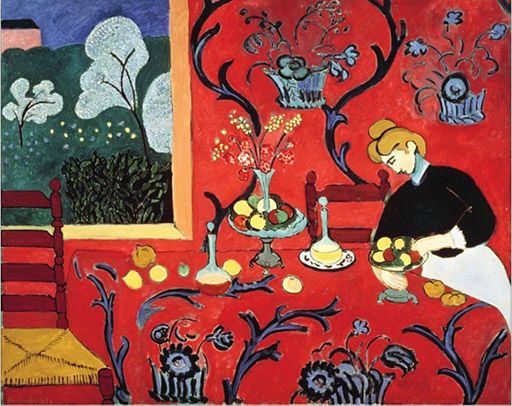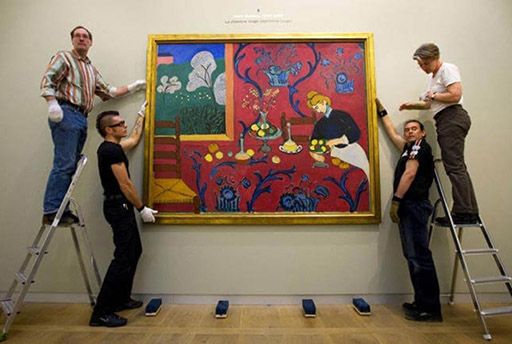The dessert: harmony in red - by Henri Matisse

Recently we published a post on the wonderful works held in the Hermitage Museum in St Petersburg and another of an exhibition at the Art Gallery of NSW from The Hermitage which was largely based on the works gathered by Russian collectors Sergey Shchukin and Ivan Morozov.
During my research I came across the fabulous work above – with its vibrant colour how could you not fall in love with this painting by Henri Matisse. It was commissioned by Sergey Shchukin in 1908, to be hung in the dining room of his Trubetskoy Palace in Moscow and now forms part of the Hermitage collection.
The title calls attention to the extraordinary red which is difficult to reproduce in photographs. Apparently, the painting was originally ordered as Harmony in Blue but Matisse didn't like it and painted over the original in red.
Matisse declared the work a decorative panel - referring to the flatness of the overall image. As you can see from the photo below it is a sizable art work.

I read that this painting is considered by some art historians to be Matisse's masterpiece and decided to research the background to this point of view.
The website henrimatisse.org gives us some understanding:
Matisse was greatly influenced by the Post-Impressionists, Van Gogh, Gauguin, Paul Cezanne; Van Gogh was an ardent admirer of Japanese art and motifs.
Matisse developed his style using areas of flat, brilliant and often unnatural colour and invariably outlined his forms in a manner similar to Van Gogh. This fauvist painting, like Impressionist Claude Monet, has no central focal point.
In his Paris studio with its windows looking out over a monastery garden, in 1908 Matisse created The dessert: Harmony in red - one of his most important works of the period 1908-1913.
Matisse turned to a motif common in painting: a room decorated with vases, fruits and flowers. Yet, as he wrote in 1908, "the basis of my thinking has not changed, but the very thinking has evolved and my means of expression have followed on."
The luxuriant raspberry red fabric with its energetic twists of blue pattern seems to sink down from the wall, taking over the surface of the table and uniting it in a single whole, swallowing up the three-dimensional space of the room and masterfully confirming the decorative potential of the canvas surface.
The wall blends into the cloth with just a faint line defining the edge of the table, while at the bottom left you barely notice the fall of the fabric at the corner of the table.
The wonderful arabesques float from the wall onto the tablecloth, carrying your eye across these elements giving the illusion of just 2 dimensions.
Matisse has used a similar trick with the chair, while through the window the nebulous shapes of the tree also leads to a flat visual image.
What do you think of this painting? Do you agree with the art historians that it is a masterpiece?
